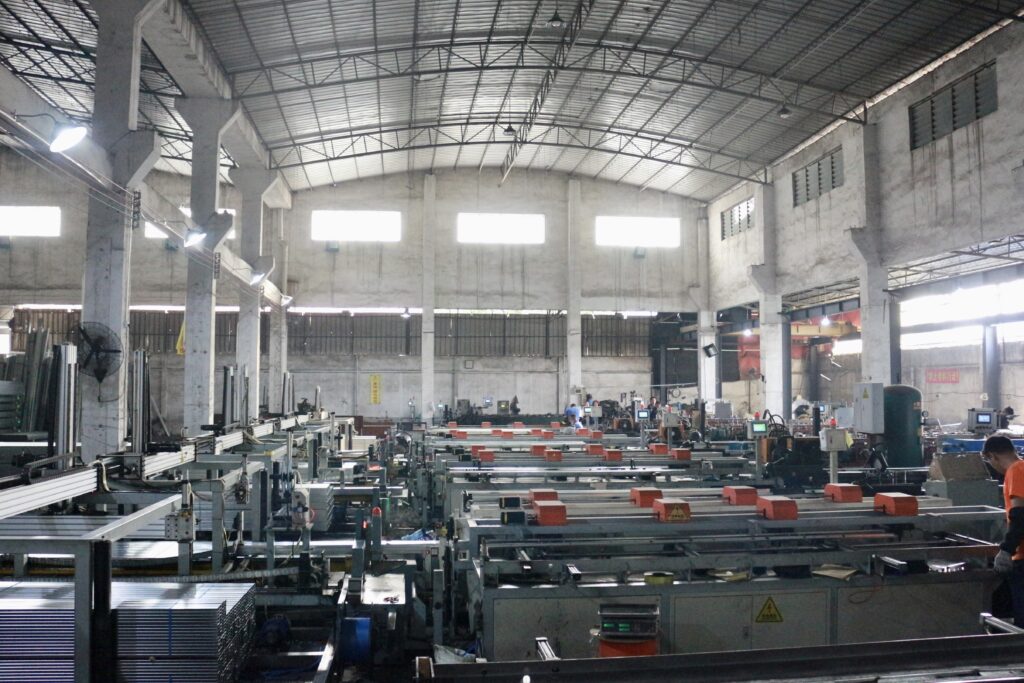
Light steel profile, a lightweight construction material, supports and secures the building frame. Its components, thin steel plates, and strips, offer lightweight, high tensile strength, and superior fire protection. Light steel profiles are typically used for interior partition walls, ceilings, flooring, and other parts to enhance building stability and safety.
Light steel profiles are widely used in Chinese public spaces, mainly divided into ceiling profiles and partition profiles. The sectional shape makes it C-type, L-type, or U-type. The ceiling profile excels in short working hours and ease of construction. This material is used in hotels, terminals, railway stations, office buildings, interior decoration, and more. It decorates non-load-bearing walls and roofs with lightweight materials such as paper-faced plasterboard and decorative plasterboard. It is ideal for roof modeling and decoration and serves as the base material for interior and exterior walls and scaffolding ceilings. Light steel profile building materials are lightweight, high strength, waterproof, shockproof, dustproof, and temperature-resistant.
High-quality profiles ensure high fire resistance. Light steel profiles are forged from top-grade high-strength steels, boasting superior fire resistance, capable of enduring a high temperature of 1000°C, safeguarding the building’s structure and contents. Moreover, they exhibit excellent corrosion resistance and durability, suitable for a variety of environments. Therefore, light steel profiles are widely used in construction.
The light steel profile production process is divided into these six steps.
- Material selection: Suitable materials are selected before making a light steel profile. Usually, it is a cold-rolled galvanized steel strip, with thickness and width varying by use and specification.
- Cutting: The steel strip is cut to the desired length and width for various applications.
- Stamping: The cut steel strip is stamped to create the basic shape of a light steel profile.
- Surface treatment: The surface of the light steel profile is treated to enhance corrosion resistance and aesthetics. Common treatments include spraying, baking paint, etc.
- Quality inspection: The light steel profile undergoes random checks to ensure that its size and flatness meet factory standards, maintaining product strength and stability.
- Packaging: The processed light steel profile is packed to ensure its safety and stability during transport and storage.
Quality assurance of steel profiles requires multi-faceted work. First, we must ensure that the quality of raw materials meets standards through rigorous testing. Secondly, in production, we must carefully monitor each stage, including deformation, size, flatness, etc., and require professional training for process operators. In addition, we must focus on product packaging and storage to prevent damage during transport and use, thus extending product life.
Above is the manufacturing process of the light steel profile. Each step requires rigorous quality control and process requirements to ensure product quality and performance. However, the question remains about choosing a profile manufacturer. To this end, we should adhere to these characteristics.
First, manufacturers of warranty profiles have skilled workers.
Why? According to industry, the better the profile manufacturers’ production personnel are, the more consistent their product quality will be. This explains why some manufacturers with advanced equipment still struggle with quality.
Next, grasp the manufacturer’s proficiency in light steel profile production.
What’s the impetus? This is the convenience society offers, such as product optimization. Therefore, a manufacturer well-versed in production management procedures, and quick to solve problems, is indispensable.
Third, when choosing profile manufacturers, their technical level is crucial.
While experienced workers can improve the quality of our light steel profiles, inadequate manufacturing technology from our profile manufacturers can lead to reduced productivity.
Although seemingly unrelated to our customers, it escalates our buying risk.
Therefore, when purchasing a light steel profile, choose manufacturers with extensive experience and skilled production management skills alongside sophisticated production technology.

